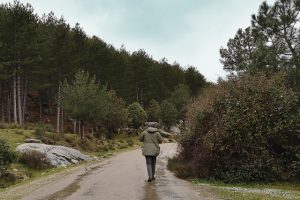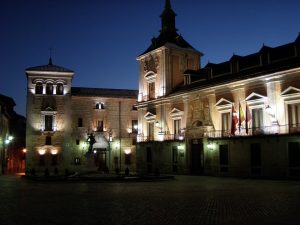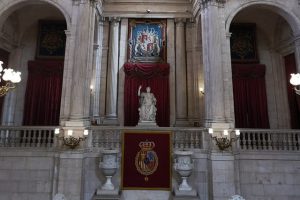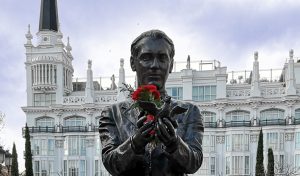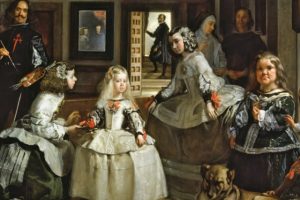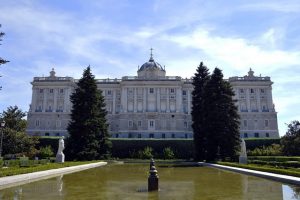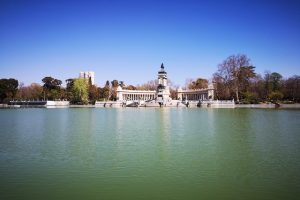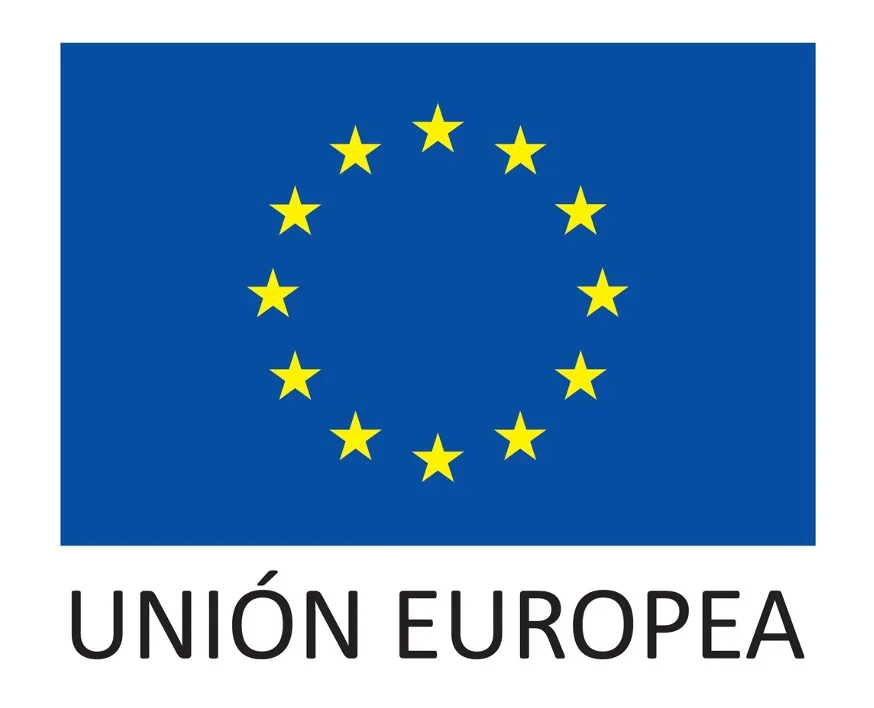What to see and do in Madrid
Madrid is a city of elegant boulevards and large well-kept royal parks. Famous for its rich collections of European art, including works by Goya, Velázquez and other Spanish masters, it is also the heart of Spain; counting on a beautiful old town, such as the Plaza Mayor, and in its vicinity with monuments of the importance of the Royal Palace and the Armory.
But Madrid is also the Sunday market of El Rastro in the medieval district of La Latina, the central Puerta del Sol square with the monument to the bear and the strawberry tree of the city’s coat of arms, the National Archaeological Museum with its rich collection of artifacts historic buildings, and the Santiago Bernabéu, Real Madrid’s stadium.
What to do in Madrid this weekend
Don’t you know what to do in Madrid for a weekend? Well, with Naturanda you won’t get bored, discover the best plans you can do in Madrid today.
What to see in Madrid in one day?
Visit Madrid in three days
Do you want to know what to see in Madrid during your next vacation? If you plan to visit Madrid, we show you what to see in Madrid in one, two and three days. Next, we share with you its main tourist attractions:
Prado Museum
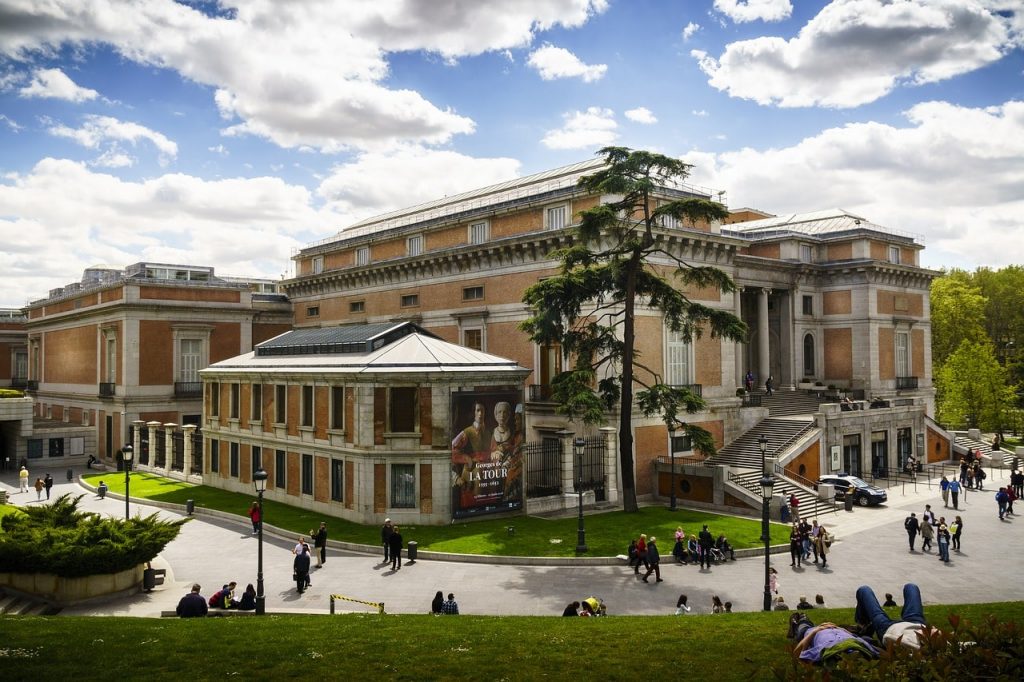
The Prado Museum was inaugurated in 1819. During that time, he has amassed an unrivaled collection of paintings, sculptures, prints, drawings, and arts and crafts that make up the history of Spanish art and make up one of the best European collections in the world. It is one of the largest museums in the world.
The Prado Museum is housed in the classicist 18th-century Villanueva Building on Paseo del Prado, with monuments to Spanish painters Diego Velázquez and Francisco Goya at its entrances.
The Prado Museum is the former Royal Museum, based on the former Spanish Royal Collection. It was transformed into the National Museum of Painting and Sculpture, and later into the Museo Nacional del Prado (Prado Museum). The collection consists of around 7,600 paintings, 1,000 sculptures, 4,800 prints, and 8,200 drawings, and includes a large collection of historical documents.
There are works by artists such as Bartolomé Bermejo, Pedro Berruguete, Sánchez Coello, El Greco, Ribera, Zurbarán, Murillo, Alonso Cano, Velázquez and Goya.
The Prado Museum brings the “Golden Triangle” to life, together with the Reina Sofía Museum (Picasso’s “Guernica” house) and the Thyssen-Bornemisza Museum.
Madrid's royal palace
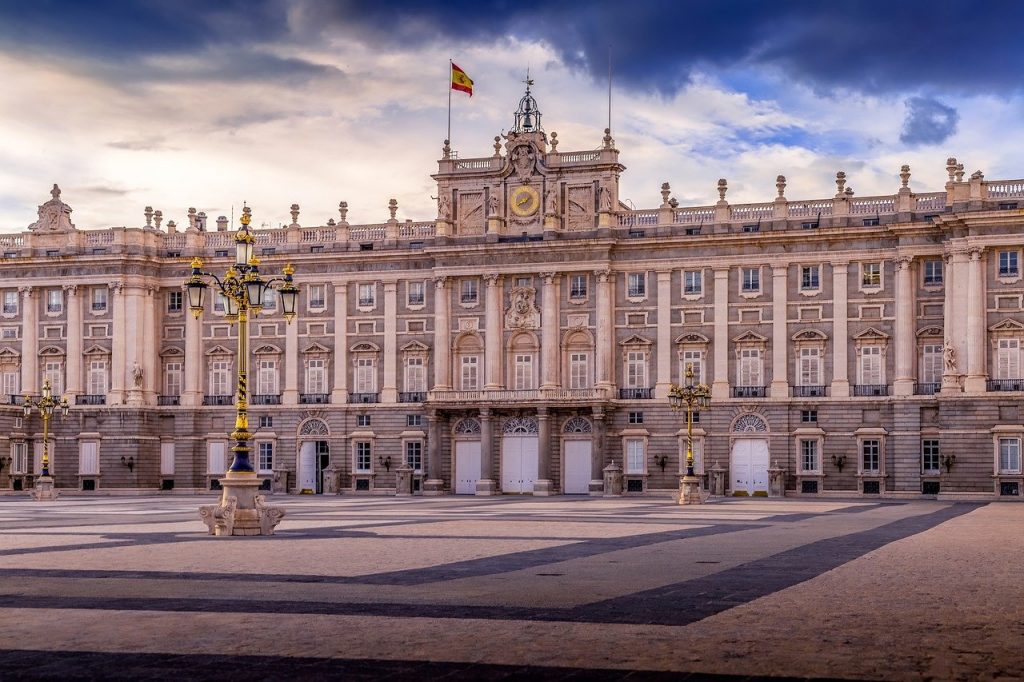
The Royal Palace of Madrid (also known as the Palacio de Oriente) was built in the 18th century by Felipe V Borbón in the baroque style, being the work of the Italian architect Filippo Juvara. The interiors of the palace and its surroundings represent the Rococo and Classicist styles. In addition, the Royal Palace of Madrid is one of the official residences of the King of Spain.
The Palacio de Oriente has 2,800 rooms, only some of which are open to tourists. The Royal Palace of Madrid is worth visiting for the invaluable works of Rubens and Velázquez, as well as for the furniture, porcelain, unique instruments or the first edition of Don Quixote. The royal rooms will delight all connoisseurs of art. Visitors can see the royal armory or the library. On the first Wednesday of the month from 12:00 to 13:00 you can see the changing of the guard ceremony.
There are also gardens on the premises of the Royal Palace. On the north side, the Sabatini Gardens, on the west side the Campo del Moro gardens.
The price of tickets for the Royal Palace of Madrid is 10 euros for the normal ticket. The opening hours of the Royal Palace of Madrid depend on the season, in the winter season from March 10 to 18 and in the summer season from September 10 to 20.
Retirement park
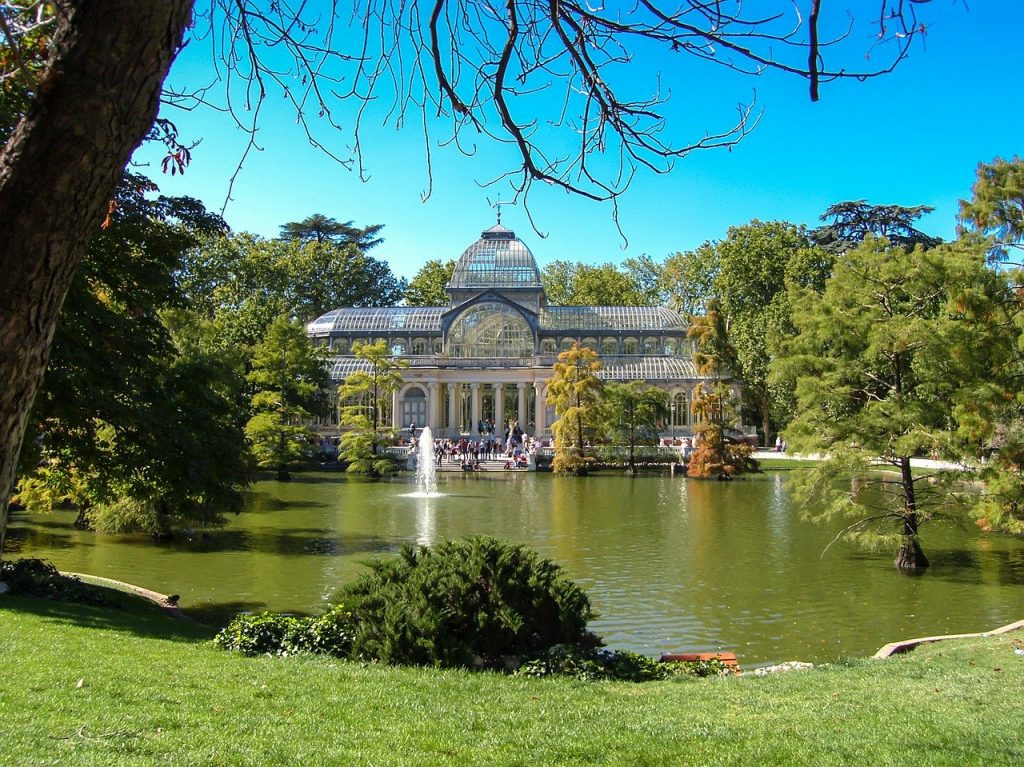
The Retiro Park is located in the eastern part of Madrid and has an area of 120 hectares. It’s worth checking out after visiting the nearby Prado Museum. In the vicinity of the Retiro Park, there are also the Reina Sofía Museum and the Royal Academy of Fine Arts of San Fernando.
The park has a semicircular colonnade with a statue of Alfonso XII, over a rectangular pond.
The park was formerly a royal garden and was made available to the people of Madrid through and with the permission of Carlos III.
We also find a large pond in the center of the park and tourist information in the historic Casa del Pescador.
In the park you can admire a garden of roses, magnolias and azaleas. 18,000 trees and 7,000 shrubs grow here, such as: poplars, chestnuts or giant sequoias, Aleppo pines and Japanese pearl trees. The most valuable specimen is the Mexican cypress, commonly known as Moctezuma Tree, which was planted in 1633 and is considered the oldest tree in Madrid.
As befits a royal park, historic fountains abound, most from the 19th century, such as the Galapagos Fountain, decorated with turtles, dolphins and frogs, or the Artichoke Fountain.
Sun Gate
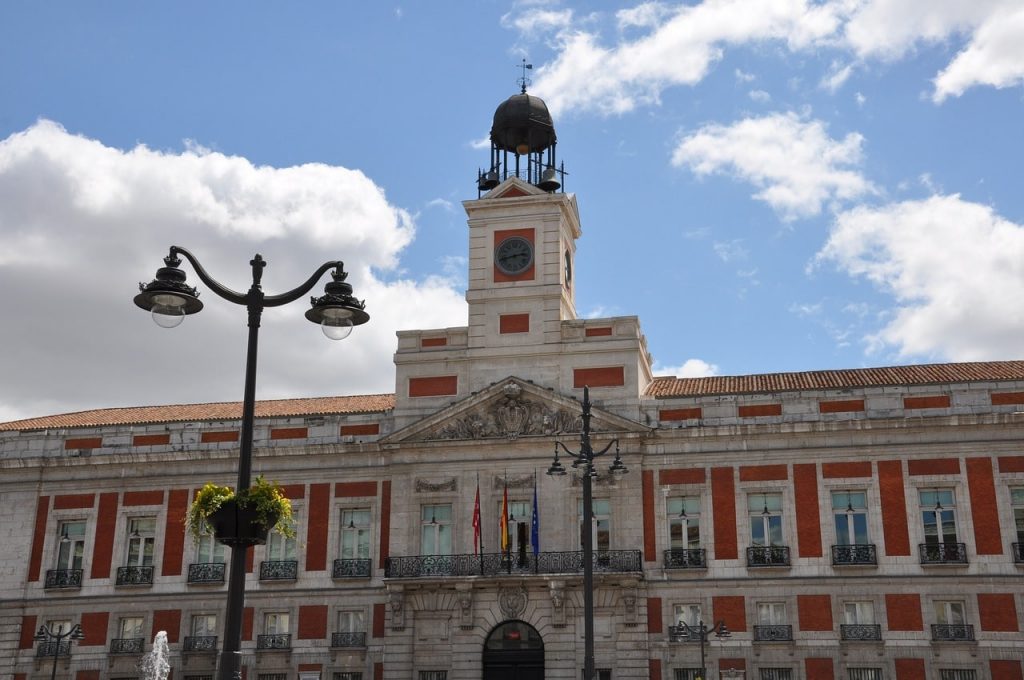
This is one of the main squares in Madrid. Recognized as the center of the capital itself, but also of all of Spain! The square houses the famous statue of a bear climbing a strawberry tree, which is considered a symbol of Madrid. The second famous statue is the statue of Carlos III on horseback, the Prince of Parma and the King of Naples.
We will also see the Real Correos (Post Office) building, which is currently in the hands of the Ministry of the Interior. Meetings of the Council of the Autonomous Province of Madrid are held here, as well as various demonstrations.
As befits the main city square, Madrid must have a clock. The Puerta del Sol clock was created by the royal watchmaker José Rodrigez Losad. It was opened in 1866 by Queen Elizabeth II.
In addition, at Puerta del Sol in Madrid, there is a “zero” point, or “zero kilometer”, which determines the length of the road to other Spanish destinations, such as Valencia, Andalusia or Catalonia.
You can get to Plaza de la Puerta del Sol by metro, since this is where the first metro line opened in 1919.
Main Square
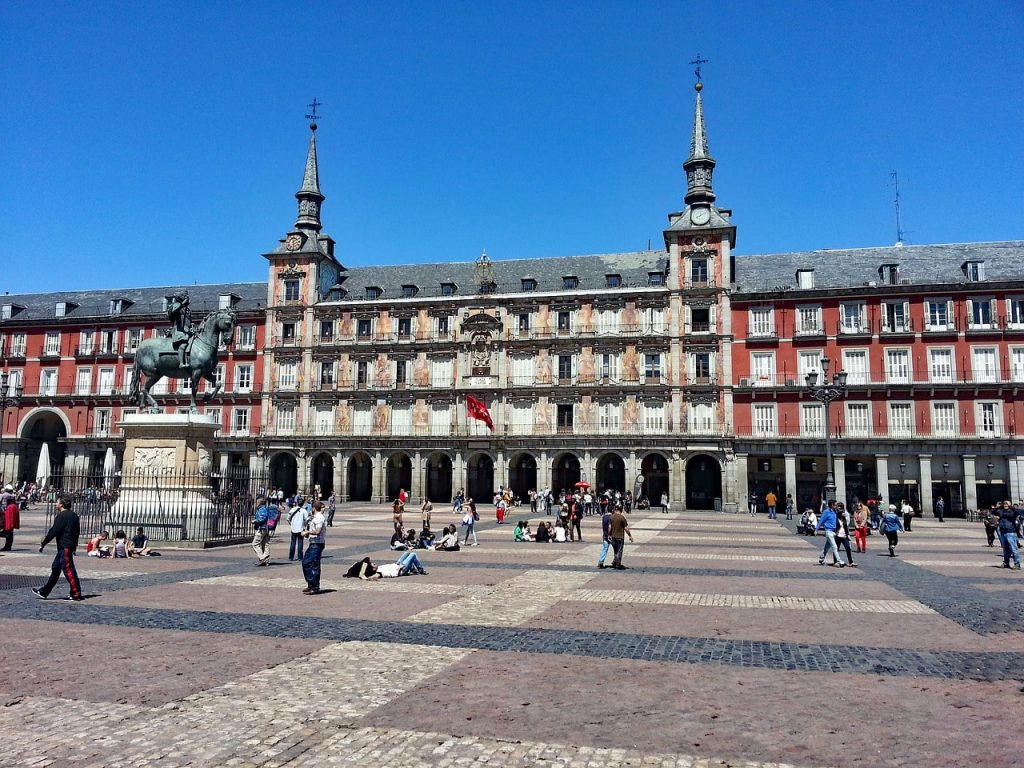
The Plaza Mayor in Madrid is another famous square in the Spanish capital. It is characterized by a rectangular floor plan of approximately 120 x 90 meters, and three-story buildings with 237 balconies located inside the plaza. There are atmospheric cafes and restaurants in the buildings, and every Sunday there is a collectors’ market for fans of vintage stamps, postcards, coins and magazines.
In the Middle Ages it was a market square on the outskirts of the city. It gained importance after Philip II moved from the capital to Madrid, when it became a place for celebrations and public meetings.
The Plaza Mayor has seen in its history public executions, corrals, coronations of kings, theatrical performances and several fires of tenement houses located nearby.
Gran Via
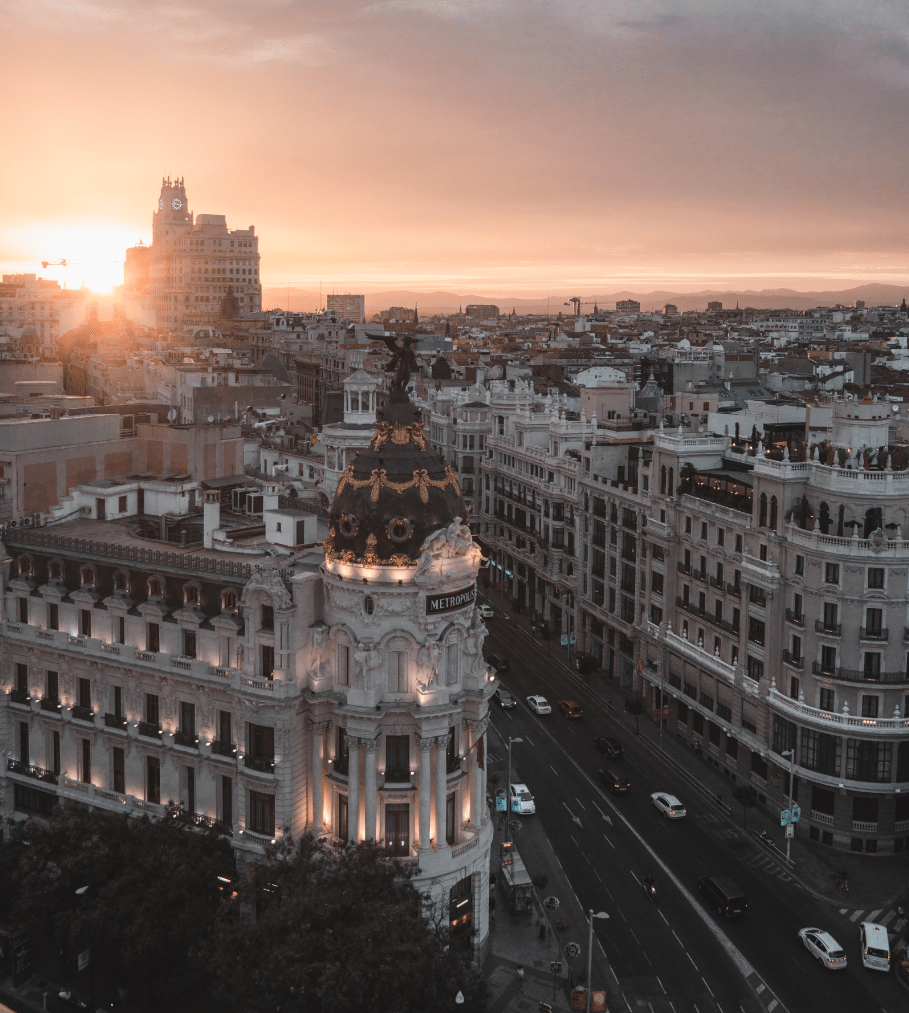
The Gran Vía in Madrid is one of the main and most famous streets in all of Spain. It is a showcase and representative streets of the capital. The street has many shops, cinemas, theaters, restaurants and hotels. It is a popular meeting place, cultural and tourist center of the capital.
Spain Square Madrid
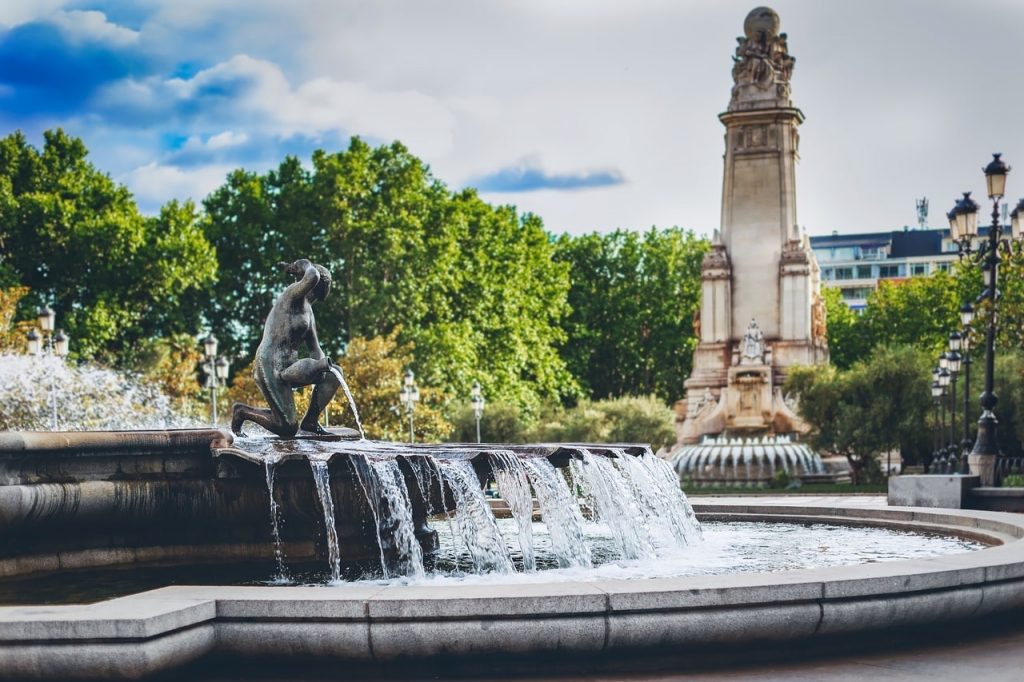
The Plaza de España in Madrid is one of the most representative squares in Madrid. It is located near the Royal Palace. Previously, it served as the site of a military garrison. At the end of the 19th and 20th centuries, the square acquired a civil and representative character. Government buildings, commercial headquarters and residential homes have been built in the Plaza de España.
The most characteristic buildings are the 26-storey skyscraper, with a swimming pool on one of the highest floors of the Edificio de España from 1948, and the 37-storey Torre de Madrid from 1957.
In the square there is a statue of Miguel Cervantes, author of Don Quixote, and in the Royal Palace you can see the original copy of the first edition.
Almudena Cathedral
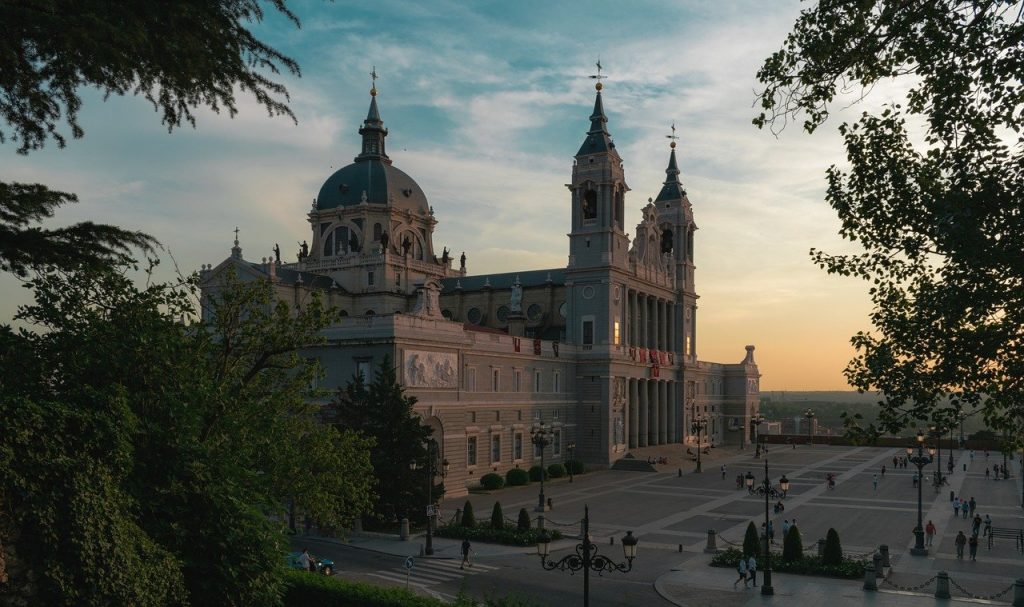
The Almudena Cathedral or Catedral de Nuestra Señora de la Almudena is the main Roman Catholic cathedral in Madrid. The cathedral is a relatively young building, dating back to the 19th century, and its construction was completed in 1993.
Taking into account the proximity of the Royal Palace, the cathedral was built in neoclassical style, while the interior in neo-Gothic style, the crypt in neo-Romanesque style.
Temple of Debod
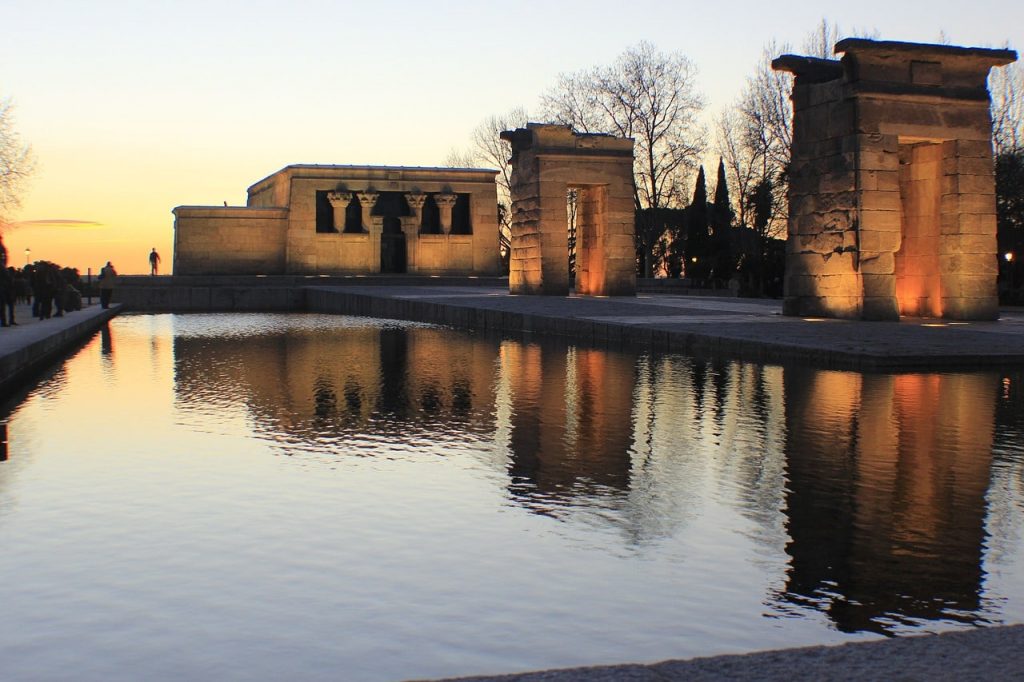
Ancient Egyptian temple in Madrid? It may not be a typical Madrid monument, because it is not related to the Spanish capital in any historical way, but aside from this fact, it is certainly an important Madrid attraction. The Temple of Debod was brought from Egypt as a gift for the help provided by Spain in the past.
The Debod temple is 2,200 years old and its original location is Debod on the Nile. The temple has several rooms, the most important of which is the chapel decorated with reliefs, which is preserved in its original state. It is the oldest part of the temple.
It was rebuilt in Madrid’s Parque de la Montaña, on the Manzanares River near the Royal Palace. From here you have a beautiful view of Casa de Campo, the largest urban park in Madrid. The temple is especially impressive in the evenings, when it is illuminated and the water reflects its contours.
Alcala Gate
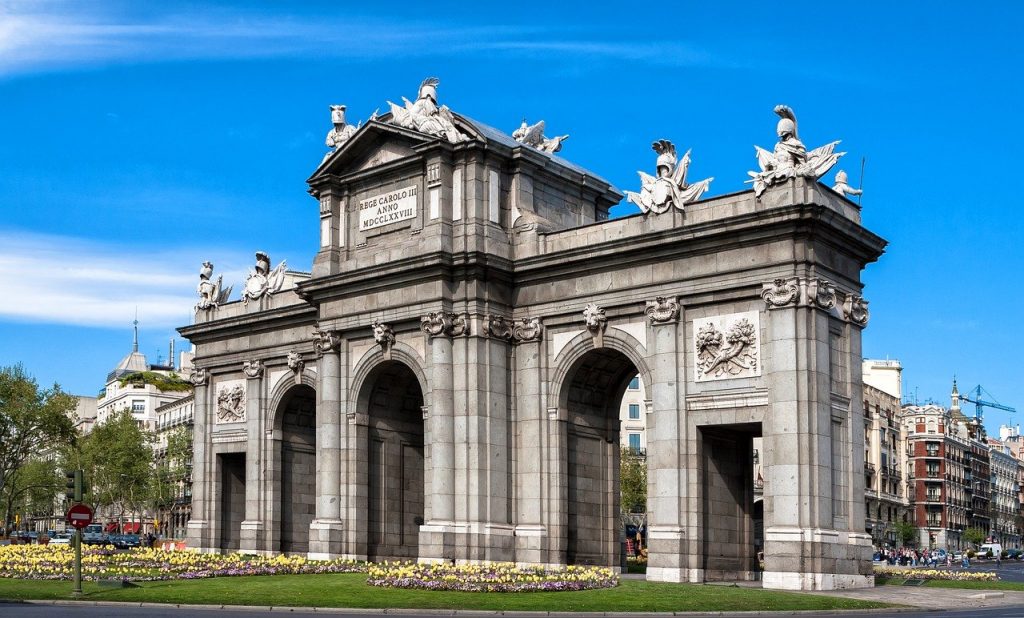
The Puerta de Alcalá is the eastern gate of the old city walls, located in the current Plaza de la Independencia in Madrid. The huge gate was made of granite and was designed by Francesco Sabatini, at the behest of King Carlos III. The door is decorated with white marble carvings. There are five entrances in the bran, decorated with arches. The central part of the Puerta de Alcalá is decorated with a stone slab that commemorates the year of construction 1778 and the king, with a shield and coat of arms that represents Fame and Genius wielding weapons.
Plaza de Cibeles
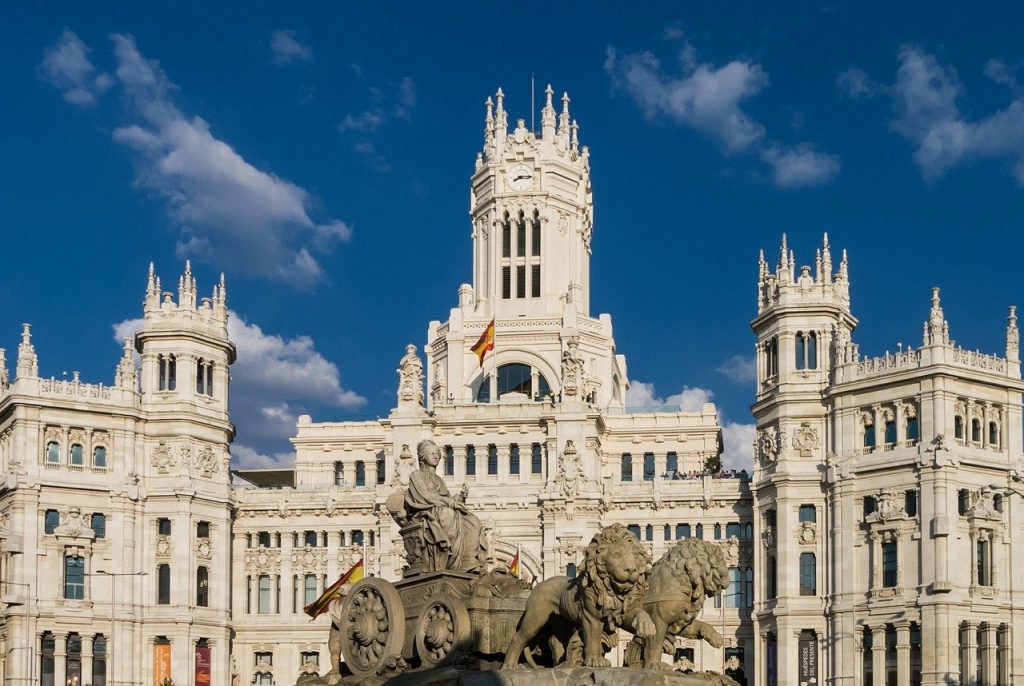
Plaza de Cibeles is a square with Madrid’s famous postcard fountain, where the sporting successes of various teams are celebrated, as well as the soccer team. In fact, the square is a busy roundabout and is the most photographed intersection in Madrid and Spain. The name of the square comes from the Fuente de Cibeles, a fountain with a statue of the Phrygian goddess Cibeles, which is considered the visiting card. The square also houses the main post office of the Palace of Communications. Since 2007, the building has been the seat of the city government and the mayor of Madrid.
Santiago Bernabeu Stadium
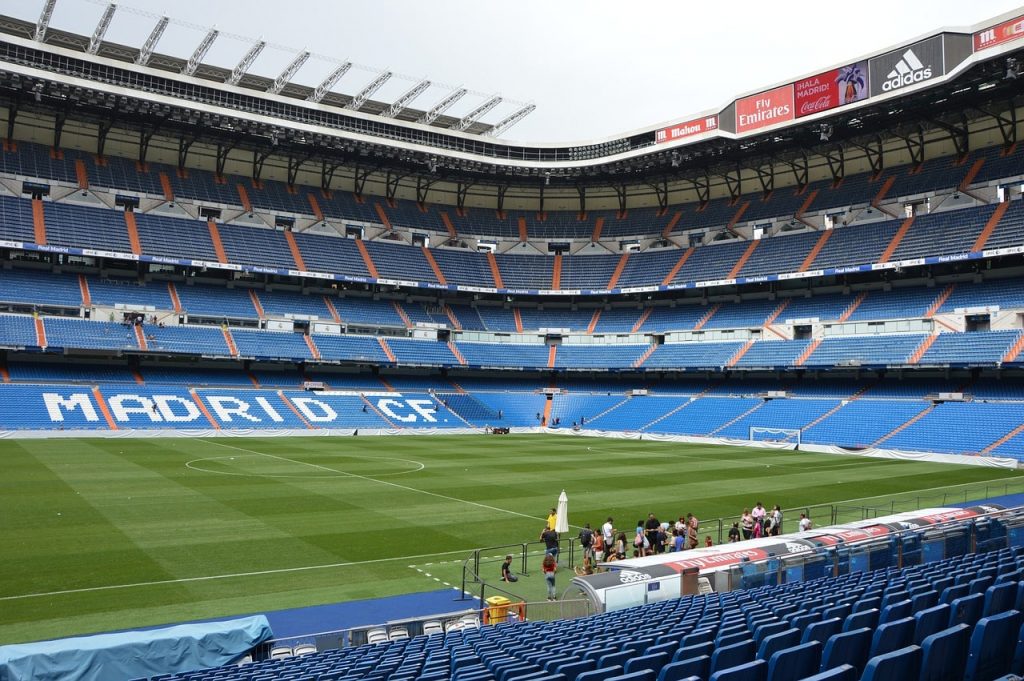
The Real Madrid football stadium is, without a doubt, a real treat for football fans. It is the headquarters of Real Madrid, and the Spanish national team also plays there. In addition, the stadium has its own metro station, Estación de Santiago Bernabéu, through which line 10 passes.
Cottage
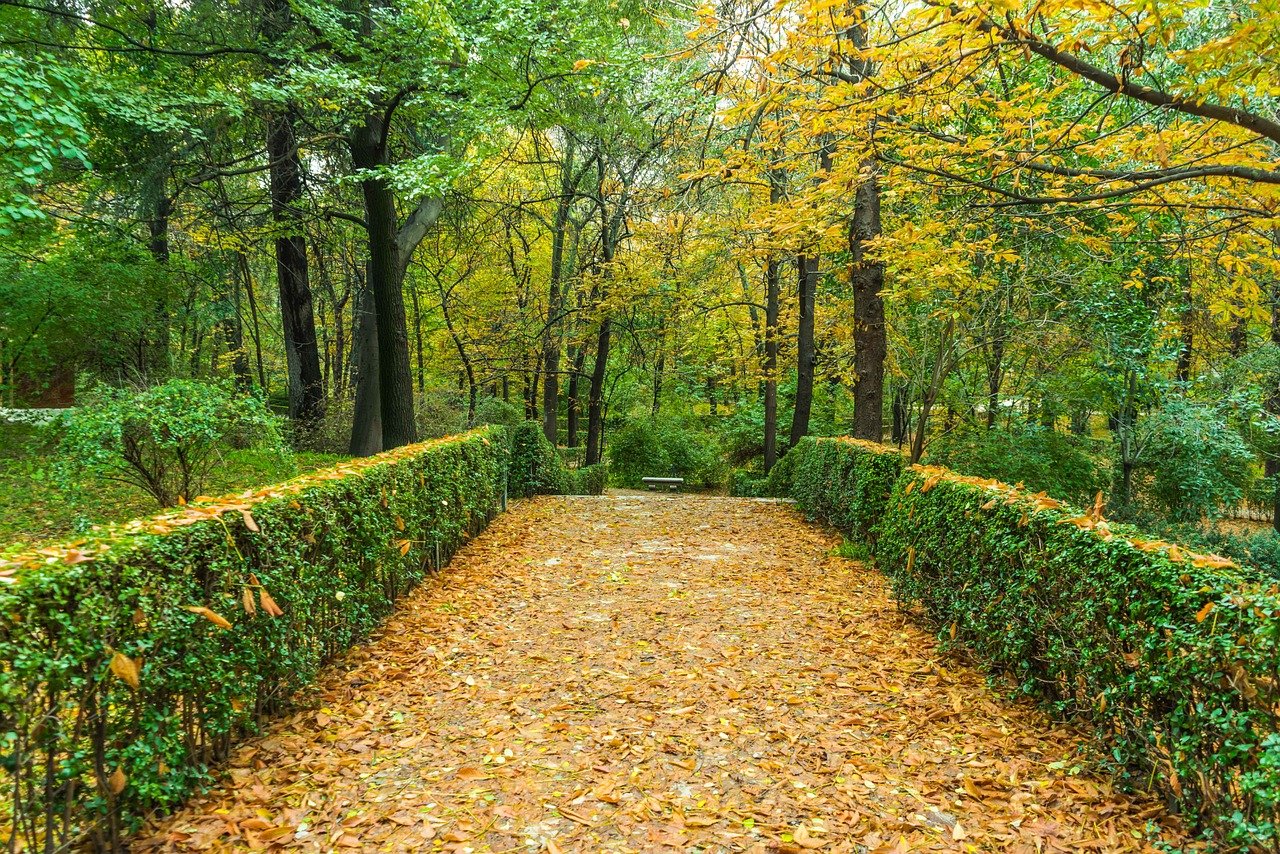
Casa de Campo is the largest park in Madrid. Its area is 1700 hectares. It used to be a royal hunting ground. In the park is the Parque de Atracciones de Madrid, which is a huge amusement park with various attractions such as: a roller coaster, carousels, a cable car and the Madrid Zoo Aquarium, that is, a zoo. In addition, the cable car from Aleja Pintor Rosales to Parque Casa de Campo is one of the attractions of Madrid.
In Casa de Campo Park you can take a boat ride on a huge artificial lake. The park is a place of rest and relaxation for residents and tourists who take a break from visiting the classic monuments of Madrid. From the park you can admire the panorama of Madrid, from the numerous viewpoints that are located here.
Likewise, this park has restaurants, picnic areas, benches and playgrounds for children.
Plaza de Oriente, Madrid
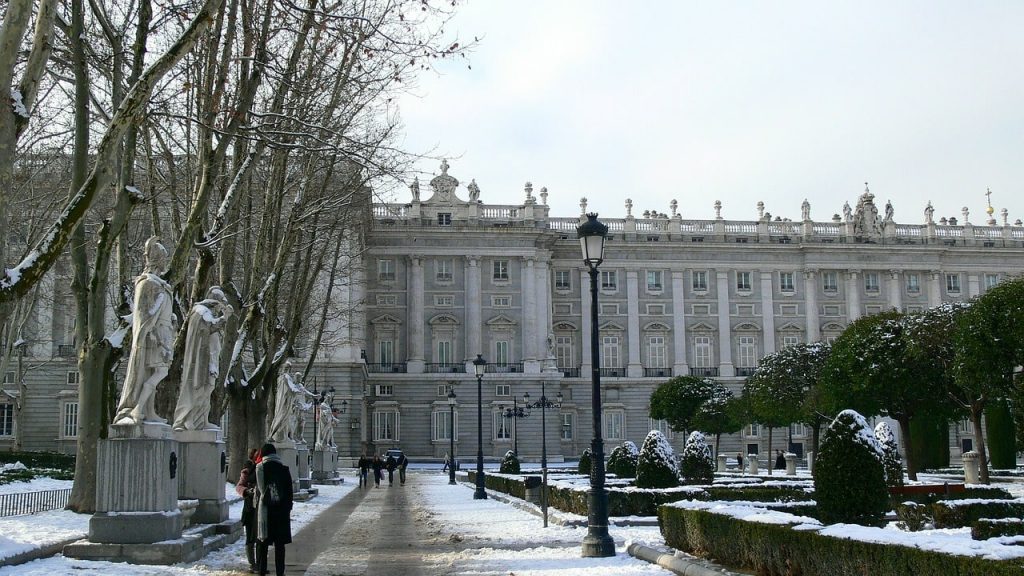
The Plaza de Oriente is a square in the historic center of Madrid. The square has a rectangular shape and a monumental character. It was designed in 1844 by Narciso Pascual y Colomer. Several important monuments of Madrid are located near the square, such as: the Royal Palace to the west, the Royal Theater to the east and the Royal Monasterio de la Encarnación to the north.
The statue of Felipe IV is located in the center of the Plaza de Oriente. In the Plaza de Oriente you can walk among bushes and trees in semicircular gardens and appreciate various statues of Spanish kings from the Middle Ages.
St. Michael's Market
Right next to the Plaza Mayor is Madrid’s famous Mercado de San Miguel. One of the most famous fairs (if not the most) in Spain.
The Mercado de San Miguel market is a true culinary experience of Spain. Here you will taste traditional dried ham, Manchego cheese, paella, seafood, tapas, fruits and vegetables, as well as wines and spirits. The second famous market in Madrid is the Mercado de San Antón. For gastronomy lovers, a guided tour and a tapas tasting are recommended.



